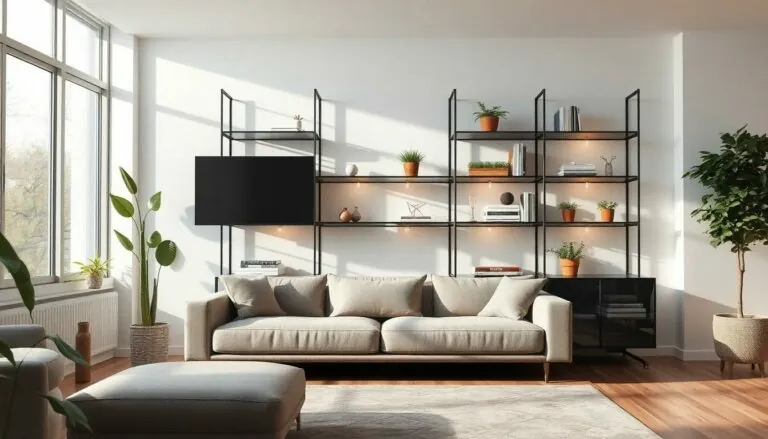Succulents are the quirky little green friends everyone wants in their home. With their unique shapes and vibrant colors, these low-maintenance plants can turn any dull corner into a lively oasis. Plus, they’re like the introverts of the plant world—perfect for those who might forget to water them for weeks on end.
Whether you’re a seasoned plant parent or just starting your indoor jungle, succulents offer a delightful blend of charm and resilience. From the popular Echeveria to the spiky allure of Aloe Vera, there’s a succulent for every personality. Get ready to discover the common succulent house plants that not only beautify your space but also bring a touch of humor and life to your home. After all, who wouldn’t want a little green buddy that thrives on neglect?
Table of Contents
ToggleOverview of Common Succulent House Plants
Common succulent house plants provide a range of options for both beginners and experienced gardeners. Echeveria stands out with its rosette shape and vibrant hues, making it a popular choice for indoor spaces. Aloe Vera, known for its medicinal properties, combines aesthetic appeal with practicality.
Haworthia offers a striking appearance with its unique patterns and is highly resilient. Jade Plant thrives in bright light and symbolizes good luck in many cultures. Lithops, or living stones, resemble pebbles, providing an interesting focal point in any collection.
String of Pearls showcases trailing foliage, perfect for hanging planters. Sedum varieties exhibit diverse shapes and colors, enhancing their visual interest. Each of these varieties requires minimal care, making them ideal for those with busy lifestyles.
Understanding each plant’s specific light and water needs can optimize their growth. Most succulents prefer well-draining soil to prevent rot, ensuring longevity. Grouping succulents with similar care requirements supports healthy growth and vibrant displays.
Incorporating these common succulent house plants into home decor enhances visual appeal while adding a touch of nature. With their low maintenance needs, these plants invite anyone to enjoy the beauty of greenery indoors.
Popular Types of Succulents
Succulents come in various types, each with distinct characteristics and care requirements. Here are some popular options to consider for indoor gardening.
Echeveria
Echeveria features a striking rosette shape complemented by vibrant colors. This succulent thrives in bright, indirect light and requires minimal watering. Growing well in well-draining soil, Echeveria won’t tolerate excessive moisture. Varieties like Echeveria ‘Lola’ and Echeveria ‘Perle von Nurnberg’ showcase different hues and unique textures. Keeping these plants in groups can enhance visual appeal, creating a stunning display.
Aloe Vera
Aloe Vera stands out for its medicinal properties as well as its visual appeal. This succulent prefers bright, indirect sunlight and needs infrequent watering. Utilizing well-draining soil supports its health, preventing root rot. Harvesting leaves provides a soothing gel for skin irritations. Common varieties such as ‘Barbadensis miller’ display the classic fleshy leaves that many recognize. With minimal care, Aloe Vera thrives indoors, making it a top choice for beginner gardeners.
Jade Plant
Jade Plant, or Crassula ovata, symbolizes prosperity and good luck in many cultures. This succulent prefers bright light and grows best with little water. Jade Plant develops fleshy, oval leaves that can take on a tree-like appearance over time. Regular pruning encourages bushiness, improving its aesthetic. Popular among collectors, this plant should be in well-draining soil to avoid root issues. Grouping Jade Plants can create a lush, inviting atmosphere in any space.
Care Tips for Succulent House Plants
Maintaining succulent house plants requires specific attention to watering and sunlight to ensure their health.
Watering Guidelines
Watering techniques play a crucial role in succulent care. Allow the top inch of soil to dry out between waterings for optimal moisture control. Depending on the season, most succulents need watering every two to three weeks, with increased frequency during warmer months. Overwatering causes root rot, a common issue for many succulent varieties. Check if the leaves appear plump and firm; this indicates adequate hydration. Conversely, shriveled leaves signal the need for water. Use pots with drainage holes to prevent excess water buildup.
Sunlight Requirements
Light conditions heavily influence the growth of succulents. Succulents generally thrive in bright, indirect light, making windowsills an ideal placement. Some species, like Aloe Vera, adapt well to direct sunlight for a few hours each day. However, too much direct light can scorch leaves. Alternate light exposure throughout the day helps prevent stress on the plants. Consider rotating pots weekly to ensure even growth. Succulents that lack sufficient light may become leggy as they stretch toward the light source. Having awareness of each plant’s sunlight needs supports vibrant displays and overall health.
Benefits of Having Succulents Indoors
Succulents offer numerous advantages as indoor plants. They improve air quality by absorbing carbon dioxide and releasing oxygen. Research demonstrates that certain succulents, like Aloe Vera, purify the air by filtering harmful toxins.
Low maintenance needs represent another significant benefit. Unlike other houseplants, succulents require minimal watering, making them suitable for busy lifestyles. Many thrive on neglect, appealing especially to novice gardeners and those who frequently travel.
Aesthetic appeal enhances any space when incorporating these plants. Varied shapes and vibrant colors add character to homes and offices. For instance, Echeveria and Jade Plant contribute distinct visual textures to indoor settings.
Their resilience provides additional appeal. Succulents tolerate dry conditions and can adapt to less-than-ideal lighting situations. They often flourish even in environments where traditional plants struggle.
Succulents also encourage mindfulness and stress relief. Caring for plants can lead to therapeutic benefits, promoting relaxation and mental well-being. Observing their slow growth fosters patience and mindfulness.
Another advantage includes their versatility in decor. Succulents suit various container styles, such as terrariums, pots, or hanging displays. This adaptability allows individuals to express personal style while creating visually engaging arrangements.
Finally, succulents often serve as excellent gifts. Their unique characteristics and ease of care make them perfect presents for plant enthusiasts and beginners alike. Giving succulents emphasizes thoughtfulness, combining beauty with practicality.




